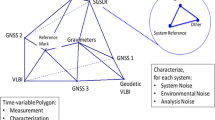Abstract
The mining town of Aggeneys is situated in a world-class polymetallic base metal district. The Black Mountain Mining Complex (BMC), located in the Northern Cape, South Africa, contains six known orebodies with more than 25.5 Mt contained metal in resources and reserves. Currently, three of the six known orebodies are actively mined. The Big Syncline East prospect is situated directly east of the massive Big Syncline mineral resource of > 150 Mt of open pit and underground resources. Big Syncline is one of the six declared resources at BMC. Recent high-power super conducting quantum interference device transient EM identified a large 3500-Siemens conductor at depths greater than 400 m. Initial follow-up drilling confirmed the presence of mineralized sulfides. A follow-up drone-based magnetic survey was flown, primarily to improve on the poor-quality, high-ground clearance magnetic data recorded with a fixed-wing aeromagnetic system, but also to trial a novel hybrid ground and drone total-field transient EM survey over the extreme topography encountered in the area. Results are very encouraging and now pave the way for more routine implementation of hybrid ground-drone total-field transient EM applications, where a large transmitting loop on the surface is surveyed by a relative fast-moving drone-carried fast-sampling total-field magnetometer.








Similar content being viewed by others
References
Agenbacht ALD (2007) The geology of the Pofadder area. Explanation to sheet 2918, scale1:250 000. South African Council for Geoscience publication, Silverton, Pretoria. 89pp. ISBN 978–1–919908–94–6
Asten MW, Duncan AC (2012) The quantitative advantages of using B-field sensors in time-domain EM measurement for mineral exploration and unexploded ordnance search. Geophysics 77(4):W137–W148. https://doi.org/10.1190/geo2011-0385.1
Barnett CT (1984) Simple inversion of time domain electromagnetic data. Geophysics 49(7):925–933. https://doi.org/10.1190/1.1441738
Becken M, Nittinger CG, Smirnova M, Steuer A, Martin T, Petersen H et al (2020) DESMEX. A novel system development for semi-airborne electromagnetic exploration. Geophysics 85(6):E253–E267. https://doi.org/10.1190/GEO2019-0336.1
Bingham D, Nimeck G, Woods D (2014) The new generation Jessy HTS SQUID TEM results over the Lalor Deposit. 2014 Lalor Symposium, Oct 16–17, Vancouver, BC Geophysical Society. http://www.bcgsonline.org/2014-lalor-symposium/. Accessed 01 Dec 2021
Boggs DB, Stanley JM, Cattach MK (1998) Feasibility studies of TFMIP and TFEM surveying with sub-audio magnetics. Explor Geophys 29:290–295. https://doi.org/10.1071/EG998290
Chwala A, Smit J, Stolz R, Zakosarenko V, Schmelz M, Fritzsch L et al (2011) Low-temperature SQUID magnetometer systems for geophysical exploration with transient electromagnetics. Supercond Sci Technol 24(12):125006. https://doi.org/10.1088/0953-2048/24/12/125006
Døssing A, da Silva ELS, Martelet G, Rasmussen TM, Gloaguen E, Petersen JT, Linde J (2021) A high-speed, light-weight scalar magnetometer bird for km scale UAV magnetic surveying: on sensor choice, bird design and quality of output data. Remote Sens 13(4):649. https://doi.org/10.3390/rs13040649
Hewitt E, Hewitt RE (1979) The Gibbs-Wilbraham phenomenon: an episode in Fourier analysis. Arch Hist Exact Sci 21(2):129–160. https://doi.org/10.1007/BF00330404
Kingman J, Halverson M, Garner SJ (2004) Stacking of controlled source electrical geophysical data: Terrigena Technical White Paper Number 20040328.0101(e)
Le Roux C, Macnae J (2007) SQUID sensors for EM systems. In: Exploration in the new millennium, Proceedings of the fifth decennial international conference on mineral exploration (pp. 417–423). https://doi.org/http://www.dmec.ca/ex07-dvd/E07/Authors2.html#M. Accessed 01 Dec 2021
Macnae J (2012) Design and testing of ARMIT magnetic field sensors for EM systems. 22nd International Geophysical Conference and Exhibition, ASEG, 26–29 February 2012 – Brisbane Australia.https://doi.org/10.1071/ASEG2012ab343
Mourant D, Smith P (1986) Addendum to the paper by Ryan et al., (1986) on the Aggeneys base metal sulfide deposits, Namaqualand District. In: Anhaeuser CR, Maske S (eds) Mineral deposits of southern Africa. Geological Society of South Africa, II, pp. 1475, ISBN 0–620–09443–5
Rozendaal A (1986) The Gamsberg zinc deposit, Namaqualand District. In: Anhaeuser CR, Maske S (eds) Mineral deposits of Southern Africa. Geological Society of South Africa, II, pp. 1477–1488, ISBN 0–620–09443–5
Ryan PJ, Lawrence AL, Lipson RD, Moore JM, Paterson A, Stedman P, Van Zyl D (1986) The Aggeneys base metal sulphide deposits, Namaqualand District. In: Anhaeuser CR, Maske S (eds) Mineral deposits of Southern Africa. Geological Society of South Africa, II, pp. 1447–1474, ISBN 0–620–09443–5
Skeels DC, Watson RJ (1949) Derivation of magnetic and gravitational quantities by surface integration. Geophysics 14:133–150. https://doi.org/10.1190/1.1437527
West GF, Macnae JC (1991) Chapter 1: Physics of the electromagnetic induction exploration method. In: Nabighian MN (ed) Electromagnetic methods in applied geophysics. Volume 2, Application, Parts A and B, Published by SEG. https://doi.org/10.1190/1.9781560802686.ch1
Acknowledgements
Firstly, Vedanta Zinc International management are thanked for their continued support for innovation and digitalization across the group and for permission to publish these results.
Special thanks go to AeroPhysX who executed the drone magnetic and EM survey at no cost to VZI and was closely involved in developing the processing code. The second author is acknowledged for initially proposing the idea of acquiring TFTEM data with the MagArrow™ sensor and Mr. Trevor Grace (MD AeroPhysX) for enabling this trial survey.
Geometrics is acknowledged for the additional input to the graph in Fig. 1 and the continued support into optimizing the MagArrow™ for novel geophysical applications requiring increased sensitivity.
The authors would like to thank BGR (Institute for Geosciences and Natural Resources, Germany) for the accurate Lidar survey over Big Syncline that was critical for the low-level drone drape survey. The high-quality false-color hyperspectral image in Fig. 3 was kindly produced and made available by the BGR.
Author information
Authors and Affiliations
Corresponding author
Ethics declarations
The work was funded in full by Vedanta Zinc International and AeroPhysX. Data and code generated during this study is proprietary to Vedanta Zinc International and AeroPhysX.
Additional information
Publisher's note
Springer Nature remains neutral with regard to jurisdictional claims in published maps and institutional affiliations.
Rights and permissions
About this article
Cite this article
Smit, J.P., Stettler, E.H., Price, A.B.W. et al. Use of drones in acquiring B-field total-field electromagnetic data for mineral exploration. Miner Econ 35, 455–465 (2022). https://doi.org/10.1007/s13563-021-00292-1
Received:
Accepted:
Published:
Issue Date:
DOI: https://doi.org/10.1007/s13563-021-00292-1




